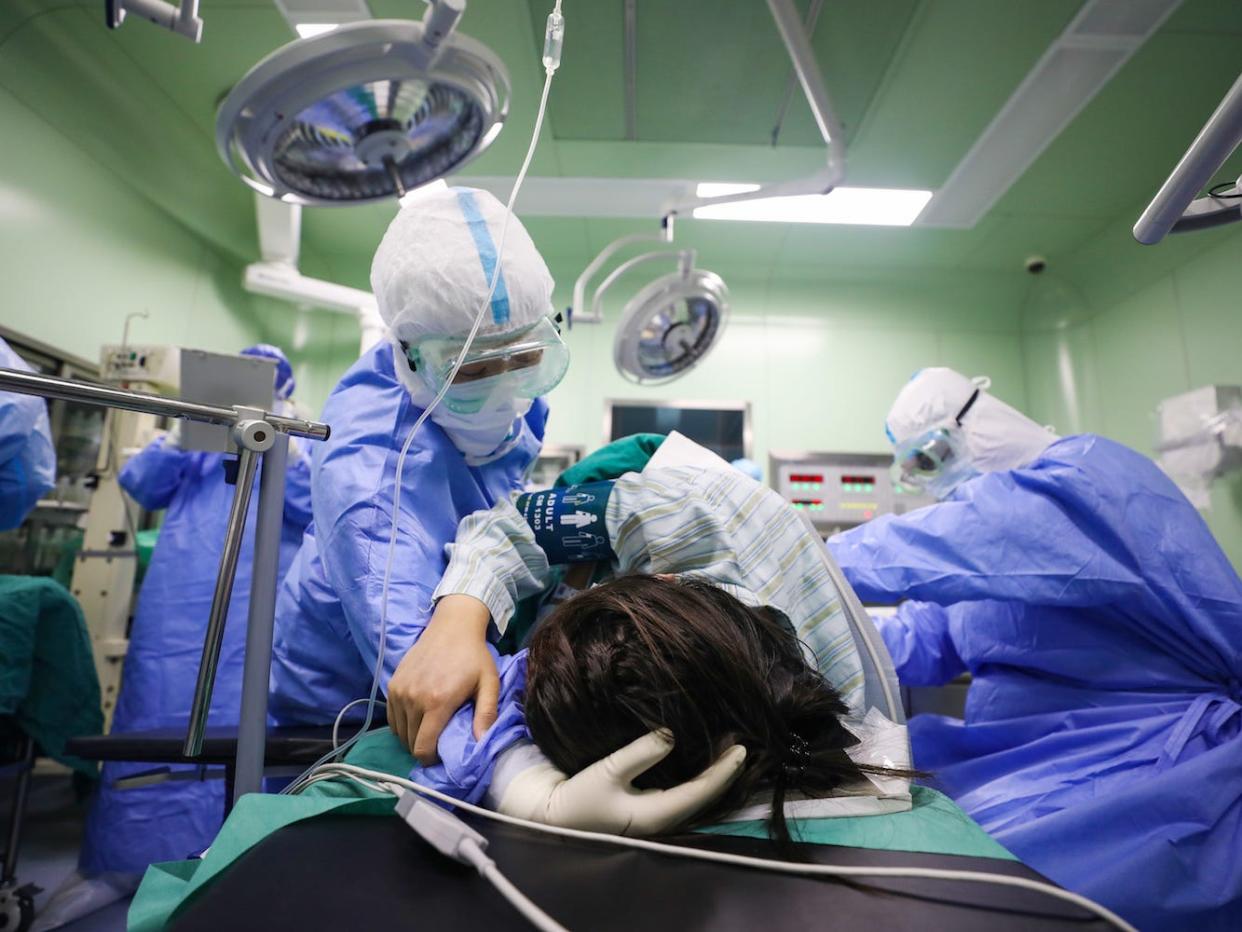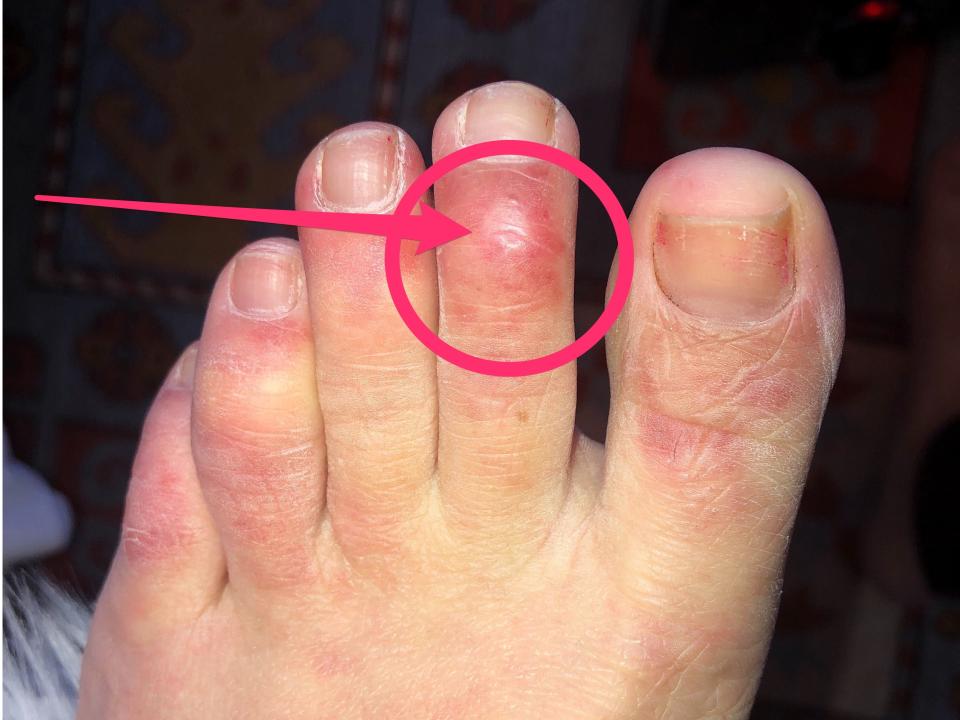Many of the coronavirus' most mysterious and dangerous symptoms have one thing in common: blood clots. This isn't solely a respiratory infection.

Feature China/Barcroft Media via Getty Images
Scientists and doctors are increasingly reporting coronavirus symptoms related to blood clots.
Blood-vessel-related complications have manifested in coronavirus patients' legs, lungs, hearts, brains, and skin.
Doctors still aren't sure how or why the virus triggers excessive clotting, but they're looking to treat these symptoms with blood-thinners and clot-busting drugs.
The coronavirus isn't just a respiratory infection.
Some of the most dangerous and least understood symptoms — from strokes to pulmonary embolisms to "COVID toes" — have been tied to excessive blood clotting.
Clots form when blood thickens, hindering flow through a vein. They usually happen in legs or arms, but clots can also move to the lungs, heart, or brain. In the most serious cases, clots can be fatal, leading to strokes, heart attacks, pulmonary embolisms, and more.
Related Video: Can You Get COVID-19 Twice?
Doctors still don't understand exactly how or why the coronavirus is causing blood clots. Lewis Kaplan, a physician at the University of Pennsylvania and head of the Society of Critical Care Medicine, told the Washington Post that doctors hadn't seen any clotting like this before.
"The problem we are having is that while we understand that there is a clot, we don't yet understand why there is a clot," he said. "We don't know. And therefore, we are scared."
Here are the coronavirus symptoms associated with blood clots.
The coronavirus causes blood clots of all sizes throughout the body
Doctors treating coronavirus patients are seeing blood clots cause kidney failure, heart inflammation, and even immune system complications.
In one high-profile New York case, a blood clot forced doctors to amputate Broadway actor Nick Cordero's leg. After he was hospitalized with COVID-19, Cordero started experiencing clotting issues in his right foot. Doctors put him on blood thinners, but that affected his blood pressure and caused intestinal bleeding. Eventually, doctors had to amputate.

Noam Galai/Getty Images for Beyond Yoga
A study of the autopsies of 12 German patients who died of COVID-19 found that about 60% had undiagnosed deep-vein thrombosis — when a blood clot forms in a vein located deep inside your body, like the legs or arms.
Blood clots can travel to the lungs, causing pulmonary embolisms
A quarter of the German COVID-19 patients analyzed in the autopsy study were killed by pulmonary embolisms. That's when large clots that form in other parts of the body travel to the lungs, blocking lung arteries.
Another study of five autopsies of coronavirus victims in New York City found that some people's lungs fill with hundreds of "micro-clots" that cause inflammation.
Pulmonary embolisms aren't always fatal: In some cases, smaller clots restrict blood flow and airflow into the lungs without creating a full blockage. That can decrease blood-oxygen levels — a common symptom of coronavirus.

Heart complications might be linked to clotting, too
Blood clots in arteries can cause heart attacks.
A study of 187 Chinese patients with COVID-19 found that nearly 30% of those studied suffered heart damage, which resulted in cardiac dysfunction and arrhythmias.
This might also be part of the reason why coronavirus patients with underlying health problems tend to have higher death rates compared to otherwise healthy patients. A Chinese CDC study found that patients with heart disease had a death rate of about 10%.
Blood clots are also tied to strokes
Strokes occur when arteries carrying blood vessels to and within the brain get blocked (which clotting can cause), or when a blood vessel ruptures.
A Dutch study of 184 coronavirus patients in the ICU found that nearly one-third of them had blood clots. Around 4% had blood clots blocking arteries.
Thomas Oxley, a neurosurgeon at Mount Sinai Hospital, previously told Business Insider that strokes have been observed in older COVID-19 patients as well as some younger patients in their 30s and 40s with mild COVID-19 symptoms. He believes these cases involved blood clots that traveled from the body into the brain.

Shutterstock
Clotting might cause some skin problems reported by coronavirus patients
Doctors have also reported clotting in the small blood vessels in coronavirus patients' skin, which causes rash-like patterns.
One highly discussed skin problem associated with the coronavirus, though still mysterious, is "COVID toes": darkened legions and swelling on the toes. Some experts believe the reaction may be due to small blood clots in the blood vessels of the feet. In the legs, swelling is one of the most common signs of clotting.
"It's possible that this is a skin reaction or caused by a small clog or micro-clots in the blood vessels found in the toes," pulmonologist Humberto Cho told the Cleveland Clinic. He added, however, that doctors are still looking into the cause of the symptom.

Dr. Lindy Fox
Doctors are racing to figure out how the coronavirus causes clots
Scientists still aren't sure why COVID-19 is causing clots. But one theory is that they're the result of blood vessels' reactions to being invaded by the virus, Oxley said.
The virus attacks cells via a receptor called ACE2, which can be found throughout the body, including in the stomach, lungs, heart, nose, and blood vessels. According to Oxley, when the virus binds to ACE2 receptors in the walls of our blood vessels, the vessels become inflamed, which can cause clotting.
Another explanation could be that the body's immune system triggers a hyperactive inflammatory response as it tries to fight the virus. That might impact its clotting factors: proteins that help control bleeding by thickening the blood.
"One of the theories is that once the body is so engaged in a fight against an invader, the body starts consuming the clotting factors, which can result in either blood clots or bleeding," Harlan Krumholz, a cardiac specialist at Yale-New Haven Hospital Center, told The Washington Post.
Other viruses such as H1N1, or swine flu, and SARS also heighten patients' risk of blood clots.
Aylin Woodward and Lydia Ramsey contributed reporting.
Read the original article on Business Insider

